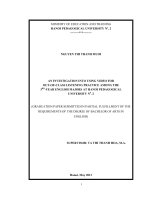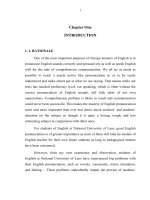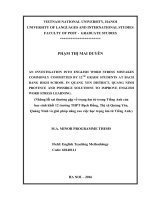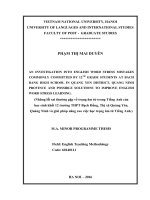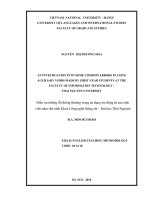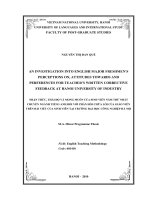AN INVESTIGATION INTO LEXICAL COLLOCATIONAL ERRORS IN ESSAYS COMMITTED BY ENGLISH-EARLY CHILDHOOD EDUCATION STUDENTS: A CASE STUDY AT HANOI NATIONAL UNIVERSITY OF EDUCATION - Full 10 điểm
Bạn đang xem bản rút gọn của tài liệu. Xem và tải ngay bản đầy đủ của tài liệu tại đây (823.69 KB, 10 trang )
TẠP CHÍ KHOA HỌC - ĐẠI HỌC ĐỒNG NAI, SỐ 18 - 2020 ISSN 2354-1482
AN INVESTIGATION INTO LEXICAL COLLOCATIONAL ERRORS
IN ESSAYS COMMITTED BY ENGLISH-EARLY CHILDHOOD
EDUCATION STUDENTS: A CASE STUDY AT HANOI NATIONAL
UNIVERSITY OF EDUCATION
Nguyễn Thị Thanh Huyền1
ABSTRACT
This study aims at classifying main types of lexical collocational errors and
identifying the possible causes of those errors in 63 essays by third-year students
majoring in both English and Early Childhood Education at Hanoi National
University of Education (HNUE) based on the taxonomy proposed by Benson et al
(1997) and Richards (1973). It was found that Type 1 (verb+noun) in lexical
collocational errors occurred most frequently in the participants' writings and the
lexical collocational errors are mainly due to the interlingual interference of
Vietnamese. Some pedagogical implications are presented to alleviate those errors.
Keywords: Lexical collocations, errors, essays, case study
1. Introduction collocations are “words in habitual
Over seven years of teaching company”.
English to Vietnamese learners, the
writers of this paper have realized that Richards and Schmidt (2002:87) [2]
despite having sufficient lexical or describe collocation as “the way in
grammatical knowledge, Vietnamese which words are used together
EFL learners seem to experience regularly.” Based on this notion,
serious problems with the production of collocation refers to the restrictions on
collocational patterns. Such erroneous how words can be collocated together;
expressions as discuss about the causes for example, which verbs and nouns go
of pollution, make decrease, and go together, or which adjectives are used
travel, just to name a few, are not due to with particular nouns. For example, in
poor mastery of grammar or lexis but English, the verb make collocates with
stem mainly from lack of appropriate friends, mistakes, or a phone call, but
collocational knowledge. Therefore, not with exercise.
identifying the problems that
Vietnamese EFL learners have with Carter (1987) [3] regarded
different types of collocations, reasons collocations as crucial factors of lexical
for those errors and remedies to deal coherence and stressed the need of
with them seems to be necessary and teaching collocations at all levels of
highlights the significance of the language proficiency. In many cases,
present study. native speakers may find it difficult to
2. Theoretical background understand a non-native speakers due to
2.1. Definition of collocations unfamiliar accents and inaccurate
According to Firth (1957) [1], a pronunciation; nevertheless, native
pioneer in collocation research, speakers can unconsciously anticipate
the meaning of sentences based on
collocations. In other words,
1Đại học Sư phạm Hà Nội 74
Email:
TẠP CHÍ KHOA HỌC - ĐẠI HỌC ĐỒNG NAI, SỐ 18 - 2020 ISSN 2354-1482
collocations, to some extent, may help - An error is what a learner cannot
compensate for such conversational self-correct.
problems.
From those definitions above, the
In the present study, the definition writer goes to a conclusion that a
of collocations focuses on co- mistake is just a slip that the learner
occurrence of words, and the forgets the right form. While, an error is
classification of collocations is based on a deviation that is made by the learner
the categories of collocations proposed because he/she does not know the rule
by Benson et al (1997) [4]. They and he/she may make it repetitively.
classified English collocations into two
major groups: lexical collocations and 2.3. Sources of error occurrence
grammatical collocations. Lexical The sources of error occurrence
collocations consist of nouns, according to Ancker (2000:1) [6]:
adjectives, verbs, and adverbs, such as (1) Interference from the native
acquire knowledge, arouse my interest, language: The learner may assume that
relieve pressure, high ambitions and the target language and his native
follow closely. On the other hand, language are similar. Then, he will over
grammatical collocations are phrases generalize the rules of his native
containing a dominant word, such as a language and the target language.
noun, an adjective, or a verb and a (2) An incomplete knowledge of the
preposition or grammatical structure target language: Because of the
like an infinitive or clause, such as feel incomplete knowledge, the learner may
sorry to, listen to the music, major in, make guesses. When he has something
and had to write. that he does not know, he may guess
what it should be there.
2.2. Errors and mistakes (3) The complexity of the target
An error and a mistake are not language: Certain aspects in target
identical, so they should be language are sometimes difficult for
differentiated from each other. some learners and even more complex
According to Yulianti (2007:9) [5], than their native language, which can
- A mistake is a performance error, cause students many troubles.
which is either a random guess or a 3. Research objectives
„slip‟, such as a failure to utilize a This paper is an attempt to analyze
known system correctly. lexical collocational errors that
- An error is a noticeable deviation constantly occur in English essays of
from the adult grammar of a native the EFL Vietnamese learners. More
speaker, reflecting the inter language specifically, this study aims to answer
competence of the learner. the following two questions:
The author also clearly 1. What lexical collocational error
differentiated a mistake from an error types are made by the participants?
by stating: 2. What are the possible causes of
- A mistake is a slip that a learner the lexical collocational errors?
can self-correct.
75
TẠP CHÍ KHOA HỌC - ĐẠI HỌC ĐỒNG NAI, SỐ 18 - 2020 ISSN 2354-1482
Possible lexical collocational errors six labels of subtypes are suggested by
found in the students' writing are Benson et al (1997) [4] while the
underlined according to the seven seventh „noun+ noun‟ subtype proposed
subtypes of lexical collocations by Hausmann (1999) [7].
mentioned in Table 1 below. The first
Table 1: Types of lexical collocations
Type Pattern Example
1 verb +noun make an impression
2 verb +adverb appreciate sincerely
3 adjective + noun heavy rain
4 adverb +adjective strictly accurate
5 noun + noun a school boy
6 noun of noun a bunch of banana
7 noun + verb naming an action bees buzz
In order to decide on the of Mobile Phones, Smoking, and Public
acceptability of the learner-made Transports) as homework assignments
collocations, Oxford Collocations without knowing that their writings
Dictionary for Students of English, were going to be under investigation. 63
which gives access to over 150,000 pieces of essays were analyzed to
collocations for nearly 9,000 identify lexical collocational errors.
headwords, available online at 5. Discussion of findings
is After finishing the process of
utilized. analyzing the participants‟ essays, it was
4. Data collection found out that there were 160 lexical
The participants, 21 third-year collocational errors in the subjects'
students who major in English and writings. These errors were classified
Early Childhood Education from Hanoi and distributed according to the seven
National University of Education, were subtypes of lexical collocations (as
asked to write essays on three different shown in the following table).
topics (Advantages and Disadvantages
Table 2: Types of lexical collocations, their number and percentage
Type Pattern Number of errors Percentage (%)
1 verb +noun 95 59.4
2 verb +adverb 11 6.9
3 adjective + noun 31 19.4
4 adverb +adjective 3 1.9
5 noun + noun 11 7
6 noun of noun 7 4.4
7 noun + verb naming an action 2 1
Total 160 100
According to the above table, it was lexical collocational errors occurred
found out that Type 1 (verb + noun) in most frequently in the participants'
76
TẠP CHÍ KHOA HỌC - ĐẠI HỌC ĐỒNG NAI, SỐ 18 - 2020 ISSN 2354-1482
writings, occupying 59.4%, followed by In order to answer the second
Type 3 (adjective + noun) with 19.4 %. question of this study to understand and
The rate for Type 2 (verb + adverb) is investigate why the participants made
as high as for Type 5 (noun + noun), the lexical collocational errors, it is
with about 7%. Type 6 (noun1 of important to find out the sources of
noun2), Type 4 (adverb + adjective), these errors. According to Richards
and Type 7 (noun + verb naming an (1973) [8], the incorrect lexical
action) make up 4.4 %, 1.9 %, and 1 %, collocations could be attributed to the
respectively. following sources:
Table 3: Sources of Collocational Errors
Sources of collocation errors Percentage (%)
Inter-lingual Transfer Negative Transfer 34
Intralingual Transfer Ignorance of Rule 19
Restrictions
False Concept Hypothesized 12.5
Overgeneralization 18
Misuse of Synonym 5.5
Paraphrase Word coinage & 11
Approximation
5.1. Negative Transfer habits have to be “unlearnt” so that they
Richards (1974:35) [9] states that can be replaced by new ones. In the
inter-lingual errors are errors caused by case of the second language (L2)
the interference of the learner's mother learning, however, the notion of
tongue. Errors of this nature are “unlearning” makes little sense, as
frequent, regardless of the learner's learners clearly do not need to forget
language background. Therefore, inter- their mother tongue (L1) in order to
lingual errors are caused by interference acquire an L2, although, in some cases,
from native language to the target the loss of the native language might
language that they learn. Before take place eventually. Where the two
someone masters the concept of the are identical, learning can take place
target language they will use the easily through positive transfer of the
concept of their native language. This native-language pattern, but where they
kind of error is called inter-lingual are different, learning difficultly arise
errors. and errors or inappropriate forms in the
As Zhiliang (2011) [10] put it: the target language resulting from negative
main impediment to learning was transfer are likely to occur.
interference from prior knowledge. The followings are some extracts
Proactive inhibition occurrs when old taken from participants‟ writings for
habits get in the way of attempts to illustrating the lexical collocational
learn new ones. In such cases, the old errors resulting from negative transfer.
77
TẠP CHÍ KHOA HỌC - ĐẠI HỌC ĐỒNG NAI, SỐ 18 - 2020 ISSN 2354-1482
Table 4: Examples of data on participants’ lexical collocational errors resulting
from negative transfer
Type Learner Collocations Target Collocations
1 When people take part in public When people use public transport,
transport, people can save money. people can save money.
3 Travelling by bus is a beautiful Travelling by bus is a good habit.
culture.
5 Studying aboard can give students Studying aboard can give students
chance job. job opportunities.
1 Without mobile phones, we can Without mobile phones, we can have
meet a lot of difficulties. a lot of difficulties.
1 Smoking can have an influence to Smoking can have an influence on
human health. human health.
In the first extract, instead of using one participant writes “Smoking can
the phrase use public transport, the have an influence to human health.”
participant uses take part in public instead of “Smoking can have an
transport, which might confuse the influence on human health.”
native speakers and challenge their 5.2. Ignorance of Rule Restrictions
interpretation. This error can be Errors of ignorance of rule
explained by the fact that in Vietnamese restrictions, which belong to
it is common to say tham gia giao intralingual transfer, are caused by the
thông, which is literally translated as failure to observe the restrictions of
take part in public transport in English. existing structure. According to
In the final extract, it can seen that Richards (1974) [9], ignorance of rule
both English and Vietnamese languages restrictions is the inability to uphold the
have prepositions, but it seems that limits of present formations,
Vietnamese people look at things from specifically, administering rules to
a different angle and hence sometimes inappropriate situations.
use prepositions differently. When Misordering can be a good example
talking about “influence” as “ảnh of such errors which are caused by
hưởng”, Vietnamese people often use ignorance of rule restrictions. Here are
the prepositions “tới”, which is a some of the participants‟ writing
Vietnamese equivalent of “to” in samples which are incorrect.
English. This explains the reason why
Table 5: Examples of data on participants’ lexical collocational errors
resulting from ignorance of rule restrictions
Type Learner Collocations Target Collocations
2 The mobile phone affects your The mobile phone affect your life
life both pros and cons. positively and negatively.
2 Mobile phone can help people Mobile phone can help people
connect easy. connect easily.
5 Lungcancer is the problem Lungcancer is the serious problem
serious in our society today. in our society today.
78
TẠP CHÍ KHOA HỌC - ĐẠI HỌC ĐỒNG NAI, SỐ 18 - 2020 ISSN 2354-1482
In the extracts above, the students tense, so they produce: He is talk to the
failed to observe the English grammar, teacher. Similarly, they think that was is
in which adverbs modify verbs and the past tense marker. Hence, they say:
adjectives often precede nouns. It was happened last night.
5.3. Overgeneralization In the sample below, the student use
Overgeneralization means the the collocation the following essay
creation of a deviant structure in place discusses about the pros and cons of
of two regular structures on the basis of smoking instead of the following essay
the students‟ experience of the target discusses the pros and cons of smoking
language. For example, some learners based on their generalization of talk
think that is is the marker of the present about.
Table 6: Examples of data on participants’ lexical collocational errors resulting
from overgeneralization
Type Learners’ Collocations Target Collocations
3 The following essay discusses The following essay discusses
about the pros and cons of the pros and cons of smoking
smoking
5.4. False Concept Hypothesized L2. For example, an L2 learner might
Another category of intralingual interpret using the forms 'was or did'
transfer is false concepts hypothesized wrongly when he/she thinks that these
errors, known as semantic errors forms are markers of the past tenses;
resulting from faulty or partial learning therefore, he/she produces utterances
of L2, rather than from language such as 'one day it was happened' or
transfer (Richards, 1973) [8]. 'she was finished the homework'
The learners might form hypotheses (Richards, 1971) [11].
about some grammatical rules of the
Table 7: Examples of data on participants’ lexical collocational errors resulting
from false concepts hypothesized
Type Learners’ Collocations Target Collocations
2 It is increasing fastly. It is increasing fast.
2 When you use the mobile phone, you When you use the mobile
often stay up lately. phone, you often stay up late.
In the examples above, it can be English, and lately, which has a diferent
seen that the committed errors are meaning from late, on the basis of their
closely connected with and not totally experience of forming adverbs from
different from overgeneralization, the adjectives.
use of previously available strategies in 5.5. The Misuse of Synonym
new situations. Specifically, the learners As can be seen from the data, some
create a deviant structure of increasing incorrect lexical collocations occur
fastly, in which fastly does not exist in because of the misuse of synonyms. It
79
TẠP CHÍ KHOA HỌC - ĐẠI HỌC ĐỒNG NAI, SỐ 18 - 2020 ISSN 2354-1482
was found out that the participants life (instead of rapid pace of life). The
failed to know the collocabitity of following table shows some examples
broaden with vision (instead of broaden of incorrect lexical collocations caused
your eyesight) or hurried with pace of by the misuse of synonym.
Table 8: Example of data on participants’ lexical collocational errors
resulting from the misuse of synonym
Type Learner Collocations Target Collocations
3 Studying abroad is a big dream of Studying abroad is a great
many students. dream of many students.
3 Hurried pace of life Rapid pace of life
3 We aren’t afraid of big rain when We aren’t afraid of heavy
we travel by bus. rain when we travel by bus.
5.6. Word coinage & Approximation which share enough semantic and
Word coinage is a kind of method morphological features to satisfy the
adopted to build new words or new needs of expressing the desired meaning.
collocations based on something For example, safe is used to get the sense
already known in order to express a of protect; talk is used to express the
desired concept. idea of tell; or boat is for ship.
Approximation refers to the fact that
learners use incorrect words or structures
Table 9: Examples of data on participants’ lexical collocational errors resulting
from word coinage and approximation
Type Learner Collocations Target Collocations
1 They must wait for a long time to They must wait for a long time to
have a bus or a train. catch a bus or a train.
1 They should not smoke to safe the They should not smoke to protect
environment. the environment.
3 Smoking can cause unaccept Smoking can cause unacceptable
behaviors. behaviors.
6. Pedagogical suggestions and The research findings fuel the
conclusion demand for a more effective
Having explained the sources of educational method to improve the
interlingual and intralingual errors, it usage of collocations in English. Three
could be clearly noticed that they are practical approaches are believed to be
interrelated and quite similar to one necessary for both lecturers and
another. These sources can only give us students to utilize optimally English
ideas about the ways in which such lexical collocations.
errors can perhaps occur, and how 6.1. Stressing the importance of
pedagogical and psychological factors error–based analysis: First, teachers
might result in errors (Mohammad, should do research on categories of mis-
2016:56) [12]. collocations. Through identifying the
learners' miscollocations, teachers not
80
TẠP CHÍ KHOA HỌC - ĐẠI HỌC ĐỒNG NAI, SỐ 18 - 2020 ISSN 2354-1482
only understand the learners' learners to practice. This way will
miscollocations but also incorporate enable the learners to develop and
them into the classroom at proper times distinguish between acceptable and
to improve and extend vocabulary unacceptable lexical collocations. Here
teaching. Then comes the designing is an example.
lexical collocation exercises for the
Choose the correct choice.
1. Single parents children without a partner‟s support are entitled to financial
help from the government. (grow/raise)
2. I‟ve never been very successful at plants. (raise/grow)
3. Jack has already a very good reputation as a talented lawyer. (achieve/win)
4. I hope your flight is on time tomorrow. Safe (trip/journey)
5. He has to stay at home and take care of his wife. His wife is a baby.
(expect/wait)
In order to improve students‟ sense correction. Following these techniques
of collocation, it is important for offers the language learners the
teachers of English to attach sufficient opportunity to notice their errors.
importance to the teaching of
collocation when teaching vocabulary. More importantly, to encourage
The teaching of a new word must be students‟ responsibility in learning how
conducted in a given context rather than to use English collocation properly, a
in isolation. The teacher should divert good dictionary can work. Dictionaries
students‟ attention to the exact context such as Oxford Advanced Learners
the new word used in and encourage Dictionary or Oxford Collocations
them to try to remember the collocation Dictionary for students of English can
the word appears in. help the learners develop better
awareness of lexical collocations.
6.2. Asking students to pay Online collocations dictionary for
attention to error correction and make students of English is also a suggested
use of English collocation dictionaries: alternative to meet the demand of
Although there are many techniques developing a good sense of collocation.
which help language learners notice the
language, teachers should put The following is the collocation of
responsibility for error correction first love on the online OXFORD
and foremost on the student. This can Collocation Dictionary with detailed
be done through self-correction, group and comprehensive explanations and
correction, and student-to-student examples.
81
TẠP CHÍ KHOA HỌC - ĐẠI HỌC ĐỒNG NAI, SỐ 18 - 2020 ISSN 2354-1482
6.3. Asking students to staying learning because they give the
researcher evidence of how far the
away from literal translation: The learner has come and what he still must
learn and they are devices learners used
majority of collocation errors collected to test out their hypothesis concerning
the language they are learning.
in this study result from translating
In this paper, seven main types of
Vietnamese to English. The participants lexical error committed by the third-
year double-majored students at Hanoi
merely translated and combined words National University of Education are
investigated and described. The study
with words to make collocations; as a also reveals that the students normally
have difficulties with collocations of the
consequence, they mostly sound verb + noun pattern, which result from
the interference of Vietnamese, the
unnatural and illegitimate. incomplete knowledge of the English
and its complexity. Some pedagogical
Consequently, it is imperative for EFL recommendations are also suggested to
deal with those problems. The study is
lecturers to remind their students that therefore hoped to be a valuable
reference for both teachers and students.
literal translation should be used with
great caution.
Despite stressing the need for an
error–based analysis, this study also
emphasizes that the errors can help and
should be taken positively. These errors
can be considered indicators of the
learners‟ language competence at a
certain point of time. They are also
considered as an obligatory feature of
REFERENCES
1. Firth, J.R. (1957), Modes of meaning, Oxford: Oxford University Press
2. Richards, J.C. and Schmids, R. (2002), Longman Dictionary of Language
Teaching and Applied Linguistics, London: Longman
82
TẠP CHÍ KHOA HỌC - ĐẠI HỌC ĐỒNG NAI, SỐ 18 - 2020 ISSN 2354-1482
3. Carter, R. (1987), Vocabulary. Applied Linguistic Perspectives, London and
New York: Routledge
4. Benson, M., Benson, E., & Ilson, R. (1997), The BBI dictionary of English
word combinations, Amsterdam: John Benjamins Publishing Company
5. Yulianti (2007), A Descriptive study of Grammatical Errors Made by the
Students of Writing III Class at the English Department of FKIP UNLAM Academic
Year 2003-2004, A Thesis, English Department of FKIP Unlam
6. Ancker, W. (2000), “Errors and corrective feedback: Updated theory and
classroom practice”, Forum, 20-25
7. Hausmann, F.J. (1999), Collocations in monolingual and bilingual English
dictionaries. In I. Vladimir & D. Kalogjera (Eds.), Languages in contact and
contrast: Essays in contact linguistics (pp. 225–236), Berlin: Mouton de Gruyter
8. Richards, J.C. (1973), A non contrastive approach to error analyses, Newbury
House Publishers, Inc
9. Richards, J. (1974), Analysis: Perspective on second language acquisition. In
J. C. Richards (Eds.), A non-contrastive approach to error analysis (pp. 172-188),
London: Longman
10. Zhiliang, L. (2011), “Negative Transfer of Chinese to College Students‟
English Writing”, Journal of Language Teaching and Research, Vol. 2, No. 5, pp.
1061-1068, September 2011
11. Richards, J. (1971), “A non-contrastive approach to error analysis”, English
language Teaching Journal, 25, 204-219
12. Mohammad H. (2016), “A Review Study of Error Analysis Theory”,
International Journal of Humanities and Social Science Research, 2016, 2, 49-59
PHÂN TÍCH LỖI SAI VỀ MẶT KẾT HỢP TỪ VỰNG TRONG BÀI VIẾT
LUẬN CỦA SINH VIÊN CHUYÊN NGÀNH TIẾNG ANH – GIÁO DỤC
MẦM NON: MỘT NGHIÊN CỨU TÌNH HUỐNG TẠI TRƯỜNG
ĐẠI HỌC SƯ PHẠM HÀ NỘI
TÓM T T
Nghiên cứu được tiến hành trên 63 bài viết luận của sinh viên năm thứ ba
chuyên ngành Tiếng Anh - Giáo dục Mầm Non tại trường Đại học Sư phạm Hà Nội
nhằm chỉ ra những loại lỗi sai cơ bản về mặt kết hợp từ vựng và xác định các nguyên
nhân gây ra các lỗi sai đó. Nghiên cứu dựa trên khung lý thuyết được đề xuất bởi
Benson và cộng sự (1997) và Richards (1973). Kết quả nghiên cứu cho thấy lỗi sai
về mặt kết hợp từ vựng xảy ra phổ biến nhất khi động từ được kết hợp với danh từ và
nguyên nhân chính của các lỗi sai là do sự ảnh hưởng của tư duy và cách diễn đạt
của tiếng mẹ đẻ. Từ đó, một số khuyến nghị về mặt sư phạm được đưa ra nhằm khắc
phục vấn đề.
Từ khóa: Kết hợp từ vựng, lỗi sai, bài luận, nghiên cứu tình huống
(Received: 17/9/2019, Revised: 20/11/2019, Accepted for publication: 6/8/2020)
83
